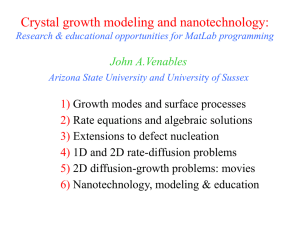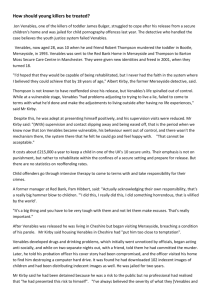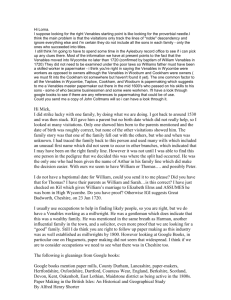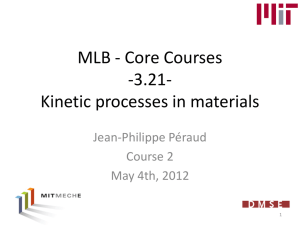Nucleation and Growth models in Nanotechnology
advertisement
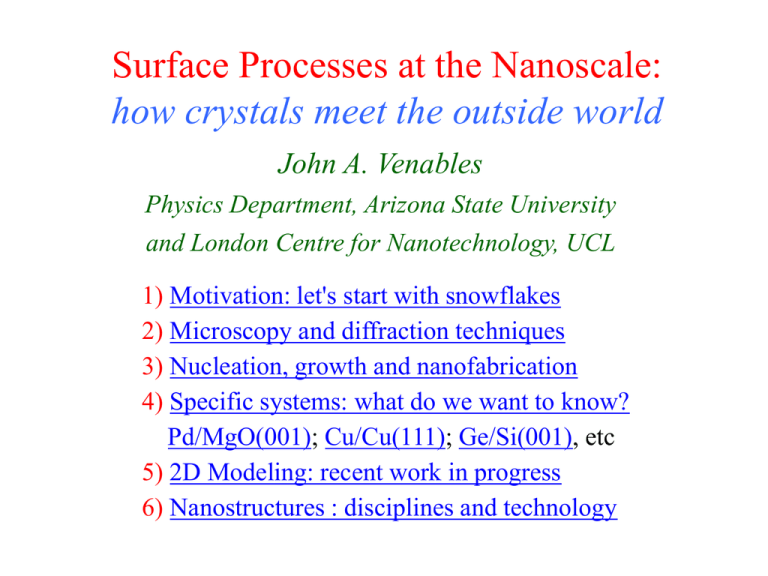
Surface Processes at the Nanoscale:
how crystals meet the outside world
John A. Venables
Physics Department, Arizona State University
and London Centre for Nanotechnology, UCL
1) Motivation: let's start with snowflakes
2) Microscopy and diffraction techniques
3) Nucleation, growth and nanofabrication
4) Specific systems: what do we want to know?
Pd/MgO(001); Cu/Cu(111); Ge/Si(001), etc
5) 2D Modeling: recent work in progress
6) Nanostructures : disciplines and technology
Scientific and Technological Motivation
• We understand binding in bulk crystals:
what is special and different at the surface?
• We understand thermodynamic equilibrium:
but useful structures are grown kinetically...
• It's the science behind the chip business:
epitaxial growth of heterostructures, lasers
• And catalytic reactions at small particles:
only chemical firms don't share their secrets
• Plus energy, health, environment and art:
enjoy nanotubes, tetrapods, snowflakes, etc.
Let's start with Snowflakes
http://www.its.caltech.edu/~atomic/snowcrystals/faqs/faqs.htm
Photos: Patricia Rasmussen, Website: Ken Libbrecht
• Wilson Bentley (1865-1931) was a
farmer near Jericho, Vermont, who
during his lifetime captured some
5000 snow crystal images. More
than 2000 were published in 1931 in
his famous book, Snow Crystals
Pioneers of
• Ukichiro Nakaya (1900-1962) was
the first person to perform a true
photo-microscopy systematic study of snow crystals.
Trained as a nuclear physicist,
Nakaya was appointed to a
professorship in Hokkaido, the
North Island of Japan, in 1932,
where there were no facilities for
nuclear research. Undaunted,
Nakaya turned his attention to snow
crystals, which were locally very
abundant. Book (1954), Snow
Crystals: Natural and Artificial.
The morphology diagram
the role of supersaturation
Driving force Dm = kTln(S);
Supersaturation S = (p/pe)
Early MC calculations, 1979
John Weeks, George Gilmer
Facets, dendrites, pattern formation
1.5 mm
• Ice Photos: Ken
Libbrecht, book
Snowflake, Winter's
secret beauty, 2003
310 nm field of view
• Pt(111) monolayers
by high-T STM:
• top row 0.15 ML
• bottom row 1 ML
• Thomas Michely &
Joachim Krug, book
Islands, Mounds and
Atoms, 2004
Early TEM pictures: Au/NaCl(001)
Donohoe and John L. Robins (1972) Journal of Crystal Growth
Field ion microscopy: diffusion of adatoms
W(211) substrate
23.06 kcal/mol = 1 eV/atom
Gert Ehrlich group UIUC, 1988-1997; Gary Kellogg 1994-1997
Scanned Probe Microscopy
621 K
424 K
0.35
3.0
275 K
12
90
UHV STM: Pt/Pt(111) T = 424 K: q ML
Helium atom scattering at different T (K)
Thomas Michely, George
Comsa group (1990-1995)
High resolution TEM: CoSi2/Si(111)
300 nm
above: platelets &
nanowires by AFM
Anouk Rougee
left: a) plan view TEM
b) platelets, c) wires:
lattice resolution cross
-section David Smith
Zhian He, David J. Smith, Peter A. Bennett PRL 93 (2004) 256102
Growth modes
Island
Volmer-Weber
Layer + Island
Stranski-Krastanov
Layer
Frank-VdM
Atomic-level processes
Variables: R (or F), T, time sequences (t)
Parameters: Ea, Ed, Eb, mobility, defects…
Competitive capture
dn1/dt = R – n1/t; t-1 = ta-1 + tn-1 + tc-1…
Venables (1987) Phys. Rev. B
Nucleation density predictions
• Matlab Programs
(R, T-1 and cluster
size, j)
• Input Energies
• Simultaneous
output: Densities
and critical cluster
size, i.
McDaniels et al. (2001) PRL; Venables et al. (2003) Proc. Roy. Soc.
Nucleation on point and line defects
(a) Point defects (vacancies) (b) Line defects (steps)
Extension to Defect Nucleation
(parameters nt, Et)
dn1/dt = R –n1/t
n1(t), single terrace adatoms
dn1t/dt = s1tDn1nte - n1tndexp(-(Et+Ed)/kT) n1t(t)
....
empty traps
trapped adatoms
dnj/dt = Uj-1 - Uj = 0 nj(t), via local equilibrium
dnj’t/dt nj’t(t),
not necessarily same i, i’
....
dnx/dt = dnj/dt = Ui - ... nx(t),
(j > i +1)
terrace cluster density
dnxt/dt = dnj’t/dt = Ui’t - ... nxt(t),
(j’ > i’ +1)
trapped cluster density
Point defects and Nanofabrication?
For Fe/CaF2(111): Heim et al. 1996, JAP; Venables 1999
Specific systems: what do we want to know?
• Metals on metals (Pt, Ag, Au...): adatom energies,
catalytic properties, templates for alloys, devices
• Semiconductors (Si, Ge, GaAs...): reconstructions,
energies, device understanding and applications
• Metals on insulators (Au/NaCl, Fe/CaF2, Pd/MgO...):
energies, role of defects, metal catalytic properties
• Metals on and in semiconductors (Ag/Si, Ti, Dy/Si...)
energies, subsurface growth, nanowires, magnetism
Experiment - kinetic model - quantum calculation
A particular case: Pd/MgO (001)
Defect nucleation,
i = 3 at high T
G. Haas et al. 2000 PRB; Venables and Harding 2000 JCG
Pd/MgO (001): parameter sensitivity
Trapping
Pair Binding
Venables and Harding 2000 J. Crystal Growth 211, 27-33
Rate equations & KMC with DFT parameters
FS+ center
Pd2
Pd3
Pd4
KMC: L. Xu, G. Henkelman, 2005-07, G. Barcaro et al, 2005
Rate equations Venables, Giordano & Harding, J. Phys. C.M. 2006
Conclusions #1
1) Nucleation & growth models have been developed
where "experimental" energies for adsorption,
diffusion, binding & trapping can be extracted.
2) Small 2D and 3D clusters are mobile on the surface,
can even be liquid; competing configurations
3) Many theoretical methods are now available to see if
such energy values are reasonable. The cases of Pd
and Ag/MgO(001) have been investigated in detail,
but results have been controversial. Are we now OK?
4) The Chemists seem to be winning! Embedded
clusters, spin polarized calculations seem to be
needed to get good values, especially for Pd, which
has competing singlet and triplet ground states.
Capture numbers:
1D radial rate-diffusion equations
dn1(r,t)/dt = G(r,t) –n1(r,t)/t(r,t) +[D(r)n1(r,t)]
G(r,t), generation rate n1(r, t), adatom profile
dnx(r,t)/dt = dnj(r,t)/dt = Ui(r,t) – ... nx(r, t)
nx(r, t) stable cluster density profile
Deals with deposition (G~F) and annealing (G~0),
plus also potential energy landscapes, V(r),
via Nernst- Einstein equation (t-dependence implicit),
j(r) = –D(r)n1(r) – [n1(r)D*(r)]V(r)
radial current
s capture number
Diffusion and attachment limits
Diffusion solution, at r = rk+ r0
sD = 2pXk0.(K1(Xk0)/ K0(Xk0)),
with Xk0 = (rk+ r0)/(D1t)1/2
Attachment (barrier) solution:
sB = 2p(rk+ r0)exp(-EB)
= B(rk+ r0) or BV(rk+ r0)
They combine inversely as
sk -1 = sB-1 + sD-1
a) B=2pexp(-EB)
b) BV=2pexp(-V0) Venables and Brune PRB 66 (2002) 195404
Delayed onset of nucleation
Reduced capture numbers: longer transient regime (nx)
Venables and Brune 2002
Repulsive adsorbate interactions: Cu/Cu(111)
Annealing, low T (16.5K),Cu/Cu(111)
Cu/Cu(111): STM, 0.0014 Rate equations, full lines as f (rd);
ML, preferred spacing
KMC, squares with error bars.
Knorr et al. PRB 65 (2002) 115420; Venables & Brune (2002) PRB
Interpolation scheme for annealing: i = 1
Full lines:
Attachment limit
Dashed lines:
Diffusion limit
Previous slides:
Interpolation
dn1/d(D1t) = -2s1n12 -sxn1nx, dnx/d(D1t) = s1n12,
with sk = sinit ft + skd(1-ft), sinit = sBft;
ft = K0(Xd)/K0(Xk0); Xd = (rk+r0+rd)/(D1t)1/2
with time-dependent rd = (0.5D1t)1/2BV/2p.
Extrapolation to higher temperatures
REs: integrate to 2
or 20 min. anneal
with given V0.
KMC: hexagonal
lattice simulations
(1000 x 1155) sites
with EB = V0.
Compare KMC-STM: 10 < V0 < 14 meV; Venables & Brune 2002
Conclusions #2:
time-dependent capture numbers
1) Explicit t-dependence involves the transient
regime and a finite number of adatoms. Barriers or
repulsive potential fields reduce capture numbers,
lengthen transients and involve more adatoms.
2) Barrier capture numbers and diffusion capture
numbers add inversely. An interpolation scheme is
needed to describe t-dependence in the transient.
3) Large critical nucleus size lengthens transient.
Annealing a low T deposit with potential fields is a
very sensitive test of t-dependent capture numbers,
as small capture numbers result in little annealing.
Extension to Ge/Si(001)
stress-limited capture numbers
• Low dimer formation energy (Ef2 ~ 0.35 eV) gives
large i, even though condensation is complete
• Stress grows with island size, sx decreases
• Lengthened transient regime results, > 1 ML, source
of very mobile ad-dimers (Ed2 ~ 1 eV) for rapid
growth eventually of dislocated islands
• Interdiffusion, and diffusion away from high stress
regions around islands, reduces stress at higher T and
lower F (e.g. at 600, not 450 oC for F ~1-3 ML/min.)
Chaparro et al. JAP 2000, Venables et al. Roy. Soc. A361 (2003) 311
Sizes and shapes in Ge/Si(001)
TEM, AFM: Chaparro, Zhang, Drucker, Smith J. Appl. Phys (2000)
Size distributions and alloying
T = 600 °C
Number of islands / cm2 / 2.5 nm
bin
1.5 x109
Strain relief via
1) interdiffusion
2) change of shape
(b
)
X2
1 x109
5
x108
Hut-dome transitions
reversible via alloying at
high T > 500 oC
0
T = 450 °C (d)
4.8
x109
5 ML
6.5 ML
8.0 ML
9.5 ML
11.0 ML
12.5 ML
3.2 x109
1.6 x109
S. Chaparro, Jeff Drucker
et al. PRL 1999, JAP 2000
0
0
40
80
120
Diameter (nm)
16
0
Ge/Si(001) STM Movies:
watching paint dry at 450 OC
gas-source MBE from Ge2H6
qGe = 5.0ML, 0.1 ML / min
T = 450 °C, 26 min/frame
62 hrs total elapsed time
first frame after 33min anneal
Field of view 600nm x 600 nm
qGe = 5.6ML, 0.2 ML / min
T = 500 °C, 7 min/frame
14 hrs total elapsed time
first frame after 160min anneal
Field of view 400nm x 400 nm
Mike McKay, John Venables and Jeff Drucker, 2007-08
7
4
30 nm
6
8
5
2
9
3
1
10
33
7
4
6
5
2
8
9
3
10
1,255
1
Ge/Si(001) hut clusters:
Annealing at T = 450 oC
9
500
30
450
400
350
300
250
200
Volume
25
Length
20
15
150
100
Width
0
1000
2000
3000
10
4000
Anneal Time (min)
4
6
5
2
7
8
9
3
1
10
2,503
7
4
6
5
8
9
2
3
1
3,751
8
500
10
30
450
400
350
300
Volume
25
Length
20
250
200
15
Width
150
100
0
1000
2000
3000
10
4000
Anneal Time (min)
Most islands static, smallest island grows (8).
Conclusions #3:
Long term annealing with barriers
1) Long term meta-stability in the Ge/Si(001) system
at intermediate T = 450 oC, ripening at 500 oC, over
long times, several days.
2) Some hut clusters to grow via growth of the short
side, but other sides do not grow. Individual facets
nucleate and grow: volume proportional to length;
nucleation barrier smallest on the shorter sides.
3) Large ad-dimer mobility and some coarsening on
and in the wetting layer. Finally dislocated dome
clusters grow, and coarsening accelerates, with
much mass transfer over large distances (many mm).
Extension to general 2D potential
dc(r)/dt = G–c(r)/t +(Dc(r))+ [(c(r)D*)( V(r))]
dc(r)/dt = G–c(r)/t +D2c(r))+A.(c(r))+ B.( V(r))
1st 3 terms, linear diffusion, sources, sinks
A. = (D+ D*(V(r)). dot product operator
B. = (c(r)D*+ c(r)D*). dot product
Starting Simplifications: 1) low concentration D = D*;
2) no distributed sinks t-1 = 0; 3) annealing G = 0.
2D Rate-diffusion simulations
Frame from 2D Movies
Connect to
MatLab files
movie #1;
isometric
movie #2;
plan view
movie #3;
capture number
with/ without
repulsive fields
J.A. Venables, J. DeGraffenreid, D. Kay & P. Yang, PRB 2006
R. Grima, DeGraffenreid, Venables, PRB 76, 233405 2007
Mean-field equations from microscopic dynamics
Strain dependent Diffusion D and Drift velocity V
as deduced by Grima, DeGraffenreid, Venables 2007
From Shu, Liu, Gong et al:
For Ge/Si(001): a1 = -1.75 eV; at lattice sites
a2 -a1 = 0.75 eV fast diffusion direction
Ge/Si(001) concentration profiles
a2= a1= -1.75 eV
a2- a1= 0.75 eV
a2- a1= 1.50 eV
R. Grima, J. DeGraffenreid and J.A. Venables, 2007, PRB
Conclusions
• Three approaches to diffusion in potential fields (Ovesson
2002, Venables & Brune 2002, Grima & Newman 2004)
"same for constant D"; but this is not generally the case.
V&B thermodynamics correct, G&N advection-diffusion
• Capture numbers are much reduced due to island potential
fields; (rectangular) updateable potentials for "strain".
• Grima & Newman's MED algorithm has been solved for
2D problems; Sum rules are exactly satisfied, including
general potential fields. Nanowire systems studied with
Ge/Si(001) model parameters (Venables et al., 2006).
• MED with "potentials due to strain" are studied (Grima,
DeGraffenreid, Venables 2007). Explicit microscopic
expressions for D & drift velocity V obtained; D changes
are more important than drift for the Ge/Si(001) model.
References
Review of capture numbers, etc
C. Ratsch & J.A. Venables: JVSTA 21 S96 (2003)
Anisotropic substrates, Restricted corner diffusion
Y. Li, M.C. Bartelt, J.W. Evans et al.: PRB 56 12539 (1997)
P. Yang & J.A. Venables: MRS 859E JJ3.2 (2005)
Numerical methods, Capture numbers in potential fields
S. Ovesson: PRL 88 116102 (2002)
J.A. Venables & H. Brune: PRB 66 195404 (2002)
R. Grima & T.J. Newman: PRE 70 036703 (2004)
J.A. Venables, J. Degraffenreid et al.: PRB 74 075412 (2006)
R. Grima, DeGraffenreid, Venables, PRB 76 233405 (2007)
Nanostructures : disciplines and technology
• Interdisciplinary environment: Physicists, Chemists,
Materials Scientists, Engineers. Interchangeable jobs:
what does each discipline bring to the table?
• Electrochemistry, solution chemistry, single molecules:
more knobs to turn, but fewer in-situ analysis tools? Do
all Inventions lead to Innovation? If not, why not?
• What will we really learn from biology? Is nano-bioanything the wave of the future, or is it just the latest
bubble, and already past its prime? Stick to basics...
• A great field for "emergent phenomena": simple rules
lead to complex results (P.W. Anderson, 1972)
Nanotechnology, modeling & education
Interest in crystal growth, atomistic models and
collaborative experiments, as illustrated in this talk
Interest in graduate education: web-based, and
web-enhanced courses and resources, book
See http://venables.asu.edu/index.html for current
projects, reference list, links to courses, resources
New Professional Science Masters (PSM) in
Nanoscience degree at ASU, now in second year
http://phy.asu.edu/graduate/psm/overview
A flurry of theoretical activity
Experiment seems to give for Pd/ MgO(001)
Et > 1.5, Ea = 1.2, Eb = 1.2 and Ed < 0.3 eV,
and much lower values for Ag/MgO(001)
Several groups try to calculate these values
J.A. Venables and J.H. Harding (2000)
D. Fuks, E. Kotomin et al. (2002-03)
A. Bogicevic and D.R. Jennison (2002)
L. Giordano... G. Pacchioni (2003-06)
L. Xu, G. Henkelman, C.T. Campbell (2005-07)
Ionic crystal + semi-classical metals
Experiment seems to give for Pd/ MgO(001)
Et > 1.5, Ea = 1.2, Eb = 1.2 and Ed < 0.3 eV, and
much lower values for Ag/MgO(001)
Pd
Ea
Ed
Ag
Ea
Ed
Mon
0.85
0.2
Mon
0.66
0.1
Dim
1.47
0.3
Dim
1.27
0.3
J.A. Venables & J.H. Harding (2000) J. Cryst. Growth:
discussion Et > 1.5, neutral F-centre, Eb free Pd2 dimer
DFT-GGA and all that VASP
Expt: Pd/ MgO(001) Et > 1.5, Ea = 1.2, Eb =
1.2 and Ed < 0.3 eV, Ea for Ag ~ 0.65 eV?
Calculation
Ads-Ea
F trap-Et
Bind-Eb Dim+t-E2t
Pd
1.34
2.72
-0.03
0.09
Ag
0.53
1.27
1.81
1.86
Pt
2.67
3.83
0.72
-0.14
Au
0.90
2.22
2.15
2.21
A. Bogicevic and D.R. Jennison (2002) Surface Sci.
Cluster chemistry: DFT-GGA + VASP
Expt: Pd/ MgO(001) Et > 1.5, Ea = 1.2, Eb = 1.2 and Ed
< 0.3 eV, and Ea for Ag/MgO(001) ~ 0.65 eV?
First emphasis on the F-centre charge state: neutral F
centre (2e- in vacancy) binds Pd (Et = 1.55 eV), not Ag;
F+ centre (e- in vacancy) binds Pd (Et = 0.77), Ag 0.99 eV
F++ centre (no e-) captures an e- from both Pd and Ag to
give F+ centre + Pd+ or Ag+ Ferrari & Pacchioni (1996)
"Oxygen vacancy: the invisible agent on oxide surfaces"
mini-review, on MgO, SiO2 and TiO2 Pacchioni (2003)
Recent cluster details: Giordano... & Pacchioni (2003-05)
Wait a moment, that can't be right...
Expt: Pd/ MgO(001) Et > 1.5, Ea = 1.2, Eb = 1.2 and Ed
< 0.3 eV, and Ea for Ag ~ 0.65 eV?
Bogicevic & Jennison (2002)
Pair-binding on the surface Eb > or << free space dimer E2?
Pd: Eb = -0.03, E2 = 1.06 ±0.16 eV; Ag: Eb = 1.81 eV , E2
= 1.65 ±0.06 eV; E2 from Gringerich (1984-85)
Charge redistribution, and hence Et in F-centre too large?
Pd: Et = 2.72 eV > Hf (PdO) = 0.9 eV; Ag: Et = 1.27 eV >
Hf (Ag2O) = 0.34 eV; Hf from Reuter & Scheffler (2004)
Fuks, Kotomin et al. (2002-03)
HF+Correl, Ea, Ed too small?: Ag: Ea ~ 0.20, Ed ~ 0.05 eV
Embedded DFT cluster + classical shell
Expt: Pd/ MgO(001) Et > 1.5, Ea = 1.2, Eb = 1.2 and Ed
< 0.3 eV? Calculated Ed = 0.34, not 0.86 eV (B&J)
Pd Ea
Terrace
Step
F
F+
DiVac
1.36
1.85
3.99
2.70
3.00
0.49
2.63
1.20
1.64
0.66
0.57
0.91
1.71
1.14
1.34
cluster
1.49
trap Et
Pd2 Eb
trap E2t
0.50
Many details, several XC functionals explored, etc; can
only give a flavor here. Giordano..& Pacchioni (2004-05)
Nanoclusters: Pd2, Pd3 and Pd4 ...
Expt: Pd/ MgO(001) Et > 1.5, Ea = 1.2, Eb = 1.2 and Ed
< 0.3 eV? Indications of i=3 and desorption at high T
Extension of same Pd2 approaches to Pd3 and Pd4:
Pd2 has minimum binding (0.57 eV) at F-center, Pd3 by a
further 0.75 eV, and Pd4 by a another 1.38 eV (all relative
to Pdn-1 on the defect and Pd1 on the terrace)
Spin polarized cluster configuration (spin singlets d10 on
surface, versus triplet d9s1 in gas phase, DE ~ 0.19 eV)
Giordano..& Pacchioni (2005)
Is i=3 likely at high T at defects? Looks good: obvious
next question in context of "believing" these energies...
Main Recent References
A. Bogicevic &D.R. Jennison Surface Sci. 515 (2002) L481-6
A.M. Ferrari & G. Pacchioni J. Chem. Phys. 100 (1996) 9032-7
D. Fuks, E.A. Kotomin et al: Surface Sci. 499 (2002) 24-40
L. Giordano... & G. Pacchioni Phys. Rev. Lett. 92 (2004) 096105;
Chem. Phys. 309 (2005) 41-7; Surface Sci. 575 (2005) 197-209
G. Haas et al. Phys. Rev. B. 61 (2000) 11105-8
G. Pacchioni Chem. Phys. Chem. 4 (2003) 1041-7 (mini-review)
C. Ratsch & J.A. Venables J. Vac. Sci. Tech. A 21 (2003) S96-109
K. Reuter & M. Scheffler Appl. Phys. A 78 (2004) 793-8
J.A. Venables & J.H. Harding J. Crystal Growth 211 (2000) 27-33
J.A. Venables et al. Phil. Trans. Roy. Soc. A 361 (2003) 311-329
Huts
Big Huts
Domes
Defective Domes
50
40
<110> Section
Dislocations
{511} disappears
30
Steeper facets + {211} + {311} + {511}
20
Trenches
Steeper facets appear
10
50
10
20
30
40
50
60
70
<100> Section
80
90 100 110 120 130 140 150 160 170
Trenches
40
{110} appears
{510} disappears
{110} + {320} + {210} + {510}
30
{320} + {210} + {510}
20
10
Dislocations
{510}
10
20
{510}
30
40
50
Side Length (nm)
60
70
80
T = 600 °C
90 100 110 120 130 140 150 160 170
Shape transitions: S. Chaparro, Jeff Drucker et al. JAP 2000
Island Dynamics Model for Epitaxial Growth
F
Compare with
v
D
•Continuum Models
(deterministic, lacks
atomic detail)
•Atomistic KMC
(stochastic, expensive)
• Islands as continuum in the plane, but individual atomic layers
• Velocity of island boundaries ?
• How do islands nucleate ? Where ?
• Evolve island boundaries with the level set method
• Treat atoms as a mean field quantity, at least initially
Alternative approaches to modeling
1) Rate and diffusion equations
2) Kinetic Monte Carlo simulations
3) Level-set and related methods
plus
4) Correlation with ab-initio calculations
Issues: Length and time scales, multi-scale;
Parameter sets, lumped parameters;
Christian Ratsch and John Venables, JVST A S96-109 (2003)
The Level Set Method: Schematic
Level Set Function j
Surface Morphology
j=0
j=0
t
j=0
j=1
j=0
• Continuous level set function is resolved on a discrete numerical grid
• Method is continuous in plane, but has discrete height resolution
The Level Set Method: Formalism
• Governing Equation:
j
+ vn | j |= 0
t
j=0
• Obtain velocity of island boundaries by solving diffusion equation:
dN
= F + D 2 - 2
t
dt
• Boundary condition
• Velocity:
=0
vn = D(n - - n + ) + Dedge ( - ave )
• Nucleation Rate:
dN
= D ( x, t ) 2
dt
• Seeding position chosen stochastically (weighted with local value of 2)
Level Set Slides: Christian Ratsch, UCLA Applied Math Department
Reversibility: Sharpening of the Island Size Distribution
KMC
Level Set
Data: Fe/Fe(001)
J.A. Stroscio and D.T.
Pierce, Phys. Rev. B
49 8522 (1994)
Petersen, Ratsch, Caflisch, Zangwill, Phys. Rev. E 64, 061602 (2001)
Microscopy and Diffraction Techniques
•
•
•
•
•
•
•
Early TEM: Au/NaCl(001) island growth example
FIM: the first to "see atoms" and diffusion paths
Scanned probe microscopy: STM, AFM and MFM
High resolution TEM, EDAX, EELS, holography
UHV analytical SEM and STEM, AES, EELS
LEEM and PEEM, SPLEEM, etc
coupled with scattering and diffraction techniques:
LEED, THEED, RHEED, X-rays and neutrons,
Helium atom scattering (HAS), RBS, ICISS....
Acronym heaven: techniques in red available at ASU
UHV SEM and STEM: AES & SAM
• ASU development, mid 80's- present: John Cowley, Peter Crozier,
Jeff Drucker, Gary Hembree, Mohan Krishnamurthy, Jingyue Liu,
Mike Scheinfein, John Spence, John Venables et al.
• UHV Applications to electronic materials and catalysis: see my
web page at http://venables.asu.edu/research/index.html
• Cowley memorial volume: J. Electron Microscopy 54 (2005) 151
LEEM and PEEM: SPLEEM & XMCDPEEM
• ASU and Trieste development, early 90's- present: Ernst Bauer,
Peter Bennett, Assia Pavlovska, Ig Tsong and co-workers
• UHV applications to surface morphology and reconstructions,
electronic and magnetic materials and catalysis: see Bauer/
Pavlovska web page at http://physics2.asu.edu/homepages/bauer/
• Review article: Reports on Progress in Physics 57 (1994) 895
Rate Equations (experimental variables T, R,t)
dn1/dt = R –n1/t
n1(t), single adatoms
....
dnj/dt = Uj-1 - Uj = 0 nj(t), via local equilibrium
....
dnx/dt = dnj/dt = Ui - ... nx(t),
(j > i +1) stable cluster density
also:
dZ/dt = f(cluster shape) Z(t), surface coverage
and
dax/dt ax(t), d/dt (t), instantaneous
mean cluster size
condensation coefficient
Differential equations versus Algebra
Using cluster shape, assumed or measured, express
nx(Z) h(Z). f1(Rpexp(E/kT))
t(Z) (Z). f2(Rpexp(E/kT));
where p and E are functions of i, critical nucleus size
similarly f3 and f4, for ax(Z) and (Z), not much used.
Choice of 1) integrating differential equations, or
2) evaluating near the maximum of nx(Z).
Steady state conditions (dnx/dt, etc = 0) converts a
set of ODE’s into a (nonlinear) algebraic solution.
Length scales in biology (Newman)
10-9 metres
DNA/genes
10-7
Proteins
complexes/
reaction
networks
10-5
Cells
10-1
Cellular
aggregates
Organisms
103
Populations
107
Ecosystems
Life on
earth
Ecosystem
biology
Evolution
theory
(adaptation/
speciation)
Information
feedback
Molecular
biology
Biochemistry
Cell
biology
Developmental
biology/
genetics
Physiology
Ecology and
population
genetics
